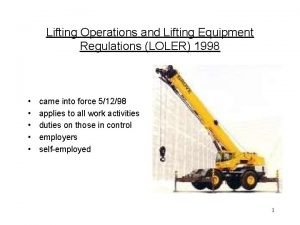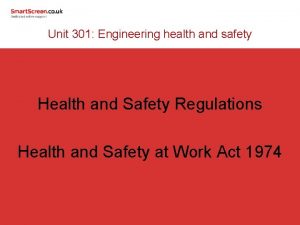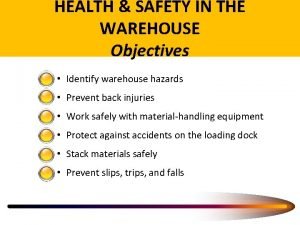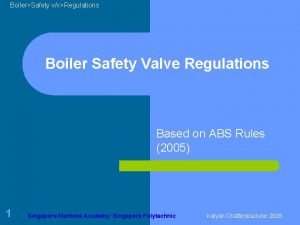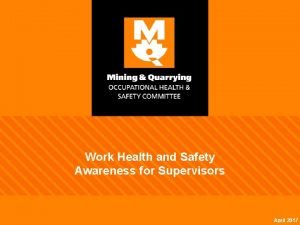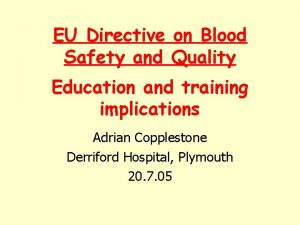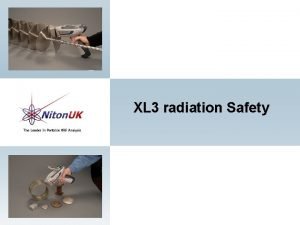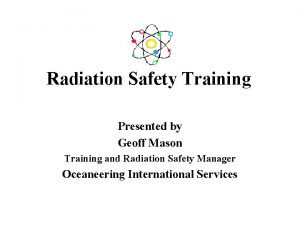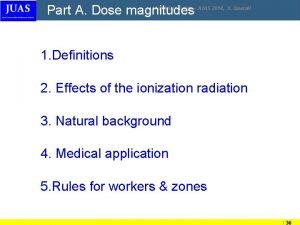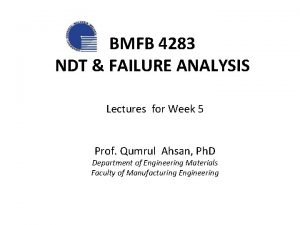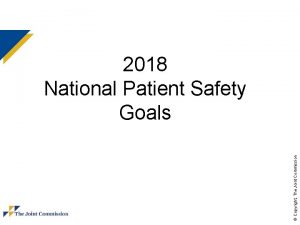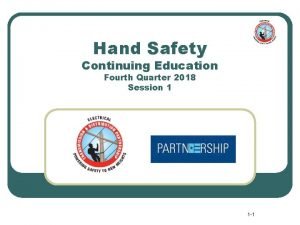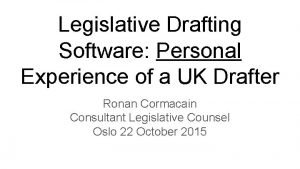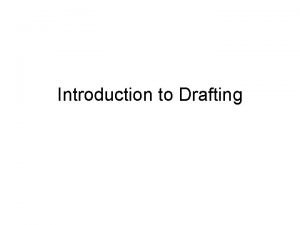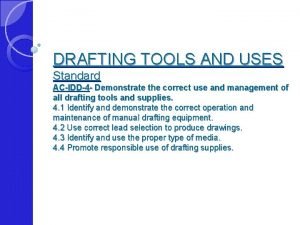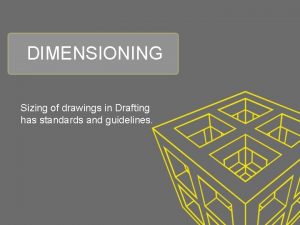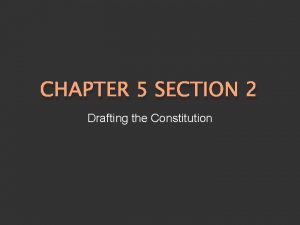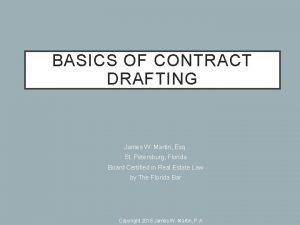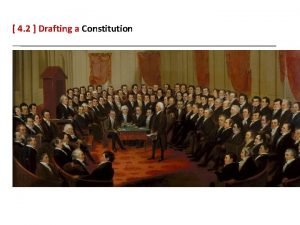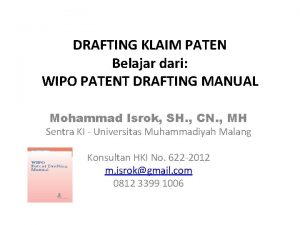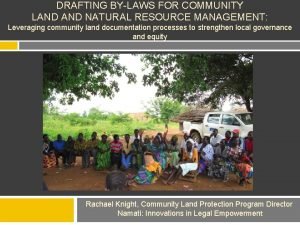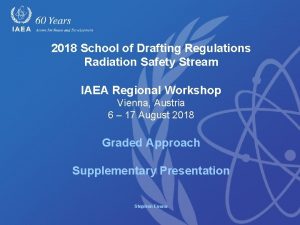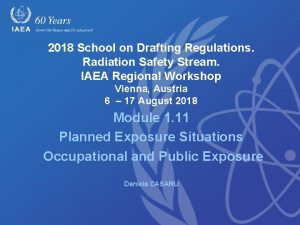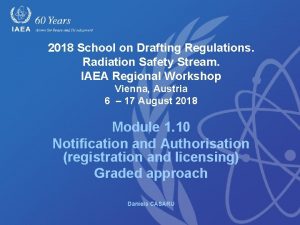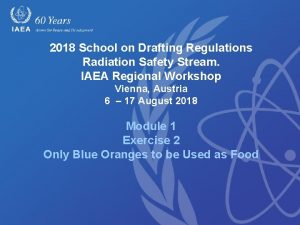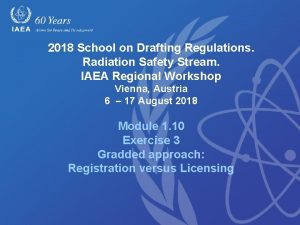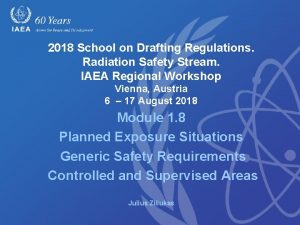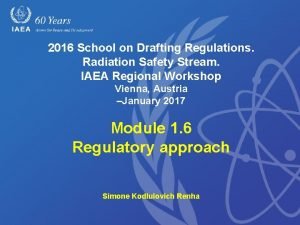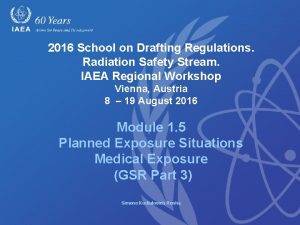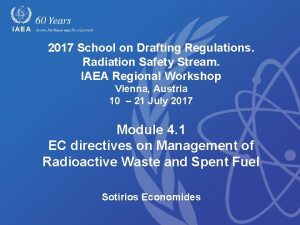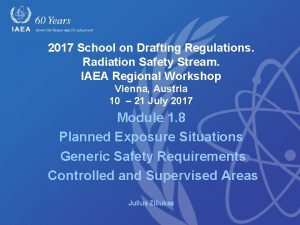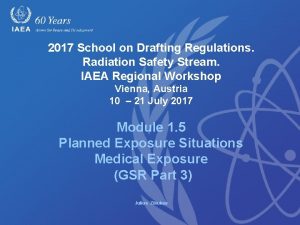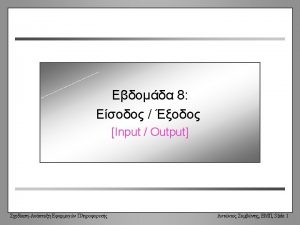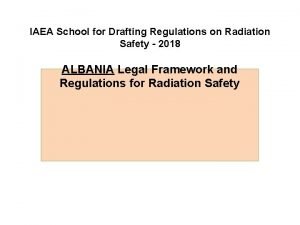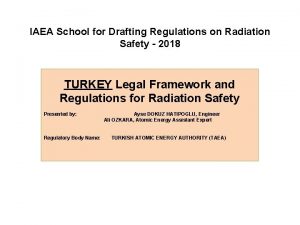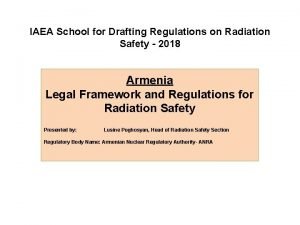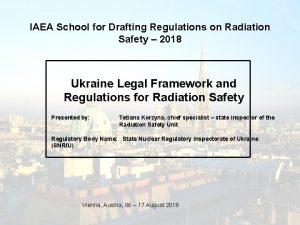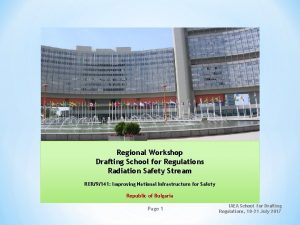2018 School on Drafting Regulations Radiation Safety Stream









































- Slides: 41

2018 School on Drafting Regulations. Radiation Safety Stream. IAEA Regional Workshop Vienna, Austria 6 – 17 August 2018 Module 1. 10 Notification and Authorisation (registration and licensing) Graded approach Daniela CASARU

Content • Graded aproach principle • Different levels in notification/authorisation and characteristics • Graded approach in safety assesment • Graded approach in decommissioning • Example – application of graded approach in Romania

What is graded approach? • For a system of control, such as a regulatory system or a safety system, a process or method in which the stringency of the control measures and conditions to be applied is commensurate, to the extent practicable, with the likelihood and possible consequences of, and the level of risk associated with a loss of control. IAEA Glossary

History of graded approach DATE: 10 -01 -2002 REVISION 1 GRADED APPROACH PROCESS PAGE 3 OF 48 GRADED APPROACH This document was designed to help … be consistent in the application of the graded approach at DOE facilities. The goal is to establish a common understanding and facilitation of the graded approach process and to provide a written reference to reduce ambiguity. At the same time it is recognized that every situation is unique and that you must adapt the graded approach that best fits your circumstances.

GSR Part 1 Rev 1: Graded Approach Requirement 1: National policy and strategy for safety “The government shall establish a national policy and strategy for safety, the implementation of which shall be subject to a graded approach in accordance with national circumstances and with the radiation risks associated with facilities and activities…”

GSR Part 3: Graded Approach Requirement 6: Graded approach „The application of the requirements of these Standards in planned exposure situations shall be commensurate with the characteristics of the practice or the source within a practice, and with the likelihood and magnitude of exposures. “ The application of the requirements of these Standards shall be in accordance with the graded approach and shall also follow to any requirements specified by the regulatory body. No person or organization shall adopt, introduce, conduct, discontinue or cease a practice, or shall, as applicable, mine, extract, process, design, manufacture, construct, assemble, install, acquire, import, export, supply, provide, distribute, loan, hire, receive, site, locate, commission, possess, use, operate, maintain, repair, transfer, decommission, disassemble, transport, store or dispose of a source within a practice other than in accordance with the requirements of these Standards.

Graded Approach Regulatory control impact Associated Radiation risk Graded Approach Reduced exposures , improved radiological safety Regulatory requirements

GRS Part 1: Implementation of Graded approach Regulation and guides Type of Authorization graded approach Inspection and Enforcement Review and Safety Assessment

Graded approach: Covers all aspects of regulatory requirements Frequency and depth of compliance activities , worker training and protective equipment graded approach public communications environmental protection program

Graded Approach: RB Allocates more efforts where risks are greater Identify, analyze the problems on the basis of risk graded approach Is a risk-informed decision making Authorizes, inspects and enforces on a risk informed basis

Graded Approaches: Considerations Limited regulatory resources: focus in higher risks Risk-informed decision: setting priorities, less complex not time consuming Communication and consultation: payoff in better decisions that are more defendable Moderate dangerous sources and practices: disproportionate amount of effort to come to decision

Categories of sources

Categories of sources in plain language

Notification and authorization, GSR Part 3 • The regulatory body shall establish a regulatory system for protection and safety that includes: Requirement 7: Notification and authorization Any person or organization intending to operate a facility or to conduct an activity shall submit to the regulatory body a notification and, as appropriate, an application for authorization.

Notification, definition, GSR Part 3 • A document submitted to the regulatory body by a person or organization to notify an intention to carry out a practice or other use of a source. • Notification is required for consumer products only with respect to manufacture, maintenance, import, export, delivery, distribution and, in some cases, disposal.

Notification - scheme

GSR Part 3: Requirement 8: Exemption and clearance • The government or the regulatory body shall determine which practices or sources within practices are to be exempted from some or all of the requirements of these Standards. • The regulatory body shall approve which sources, including materials and objects, within notified practices or authorized practices may be cleared from regulatory control.

Criteria for notification • Notification alone is sufficient provided that – the exposures expected are unlikely to exceed a small fraction of the relevant limits, – the likelihood and magnitude of potential exposures and any other potential detrimental consequences are negligible.

Authorization, definition GSR Part 3 • Any person or organization intending to carry out any of the actions …. shall, unless notification alone is sufficient, apply to the regulatory body for authorization, which shall take the form of either registration or licensing. Any person or organization applying for authorization: • Shall submit to the regulatory body the relevant information necessary to support the application; • Shall refrain from carrying out any of the actions specified in … until the registration or license has been granted; • Shall assess the nature, likelihood and magnitude of the expected exposures due to the source and shall take all necessary measures for protection and safety; • Shall, if there is a possibility for an exposure to be greater than a level as specified by the regulatory body, have a safety assessment made and submitted to the regulatory body as part of the application; • Shall, as required by the regulatory body, have an appropriate prospective assessment made for radiological environmental impacts, commensurate with the radiation risks associated with the facility or activity.

Authorisation - scheme

Registration or licensing?

Registration - criteria Registration is best suited to those practices for which operations do not vary significantly.

IAEA Tecdoc 1525: Notification and Authorization for the Use of Radiation Sources • Provides guidelines for – applicants on notification, – applicants on authorization for: • • • diagnostic radiology & dental practices nuclear medicine radiotherapy industrial radiography irradiators gauges for well logging

Graded levels of authorization • Requirements vary depending on the specific type of practice – The extent of information required in an application – The limits, conditions and controls imposed on the authorization – Licensing of facility’s life cycle stages: • each stage can be started after regulatory review proved safe completion of the previous stage and licensee demonstrated safety of the next stage (e. g. radiotherapy department construction and operation).

Validity of an authorization • An authorization might be issued for – an unlimited time (no specified renewal period); – for a specified time period (periodic renewal); – for a once-off purpose. e. g. a single import transaction.

IAEA GSR Part 4 Rev 1 Safety Assessment for Facilities & Activities • Requirement 1: Graded approach to safety assessment • A graded approach shall be used in determining the scope and level of detail of the safety assessment carried out at a particular stage for any particular facility or activity, consistent with the magnitude of the possible radiation risks arising from the facility or activity.

Graded approach in safety assessment • Main factors to be considered: – magnitude of the possible radiation risks; – releases of radioactive material in normal operation; – potential consequences of anticipated operational occurrences and possible accident conditions; – possibility of the occurrence of very low probability events with potentially high consequences.

IAEA GSR Part 6 Decommissioning of Facilities • Requirement 2: Graded approach in decommissioning – A graded approach shall be applied in all aspects of decommissioning in determining the scope and level of detail for any particular facility, consistent with the magnitude of the possible radiation risks arising from the decommissioning.

Example of Graded Approach Implementation: ROMANIA Risk Regulatory Resources Graded Approach Regulatory Compliance History of operation

Regulatory Control Licencing Registration Notification INSPECTION

Notification • All practices shall be notified in advance • All notified practices not exempt from regulatory control are subject to authorization • Practices involving NORM, including research and relevant secondary processes • Workplaces where the radon activity concentration in air is higher than 300 Bq/m³

Authorization Process • REGISTRATION – Low risk – Good operation records – Good compliance with regulatory requirements – Certificate issued for 10 years • LICENSING – Medium & high risk – Inspection mandatory to issue the licence – Licence issued for 5 years

Registration - Medical Conventional radiology, except CT Mammography Dental radiology, DEXA Veterinary radiology

Registration – Industrial Defectoscopy Practices with category 4 & 5 sealed radioactive sources Practices with unsealed sources of activity up to 1000 times the exemption level CNCAN may include other practices according to specific legal provisions

Licensing – Medical Computed tomography Angiography Radiotherapy Nuclear Medicine

Licensing – Industrial Practices with category 1, 2 & 3 sealed radioactive sources X – ray industrial radiography Practices with linear accelerators

Licensing – Additional areas Deliberate addition of radioactive substances in the manufacture or production of consumer products, including farmaceuticals Reciclying of radioactive material resulted from any authorized practice Practices discharging significant amounts of radioactive material with airborne or liquid effluent into the environment

Planned Exposure Situations: Medical exposure High Risk Practices (Radiotherapy, Nuclear Medicine) Mandatory: RPO on site, MPE on site, medical physicist, RPE Medium risk practices (CT, angiography) Mandatory: RPO on site, MPE/medical physicist available, RPE available Low risk practices: Mandatory: RPO on site, periodic advice of a RPE

Planned Exposure Situations: Industrial and other applications ELI-NP facility (high risk) RP group and a RPE on site Facilities with medium risk RPO on site, RPE available Facilities with low risk RPO on site, periodic advice of a RPE

Inspections • High risk and medium risk practices : mandatory for granting the licence; • Low risk practices: usually in 6 months after the registration; • Regular Inspection Program: - planned inspection according to the risk of the facility, previous inspection results, facility history; • Frequency : - according to the risk of facility – graded approach; • Inspection procedures according to the type of facility (graded approach)

Thank you!
 Differentiate byte stream and character stream
Differentiate byte stream and character stream Irda (insurance brokers) regulations 2018
Irda (insurance brokers) regulations 2018 Loler regulations 2018
Loler regulations 2018 Health and safety regulations in engineering
Health and safety regulations in engineering Six pack health and safety regulations
Six pack health and safety regulations Warehouse health and safety
Warehouse health and safety Food safety regulations and standards
Food safety regulations and standards H&s six pack
H&s six pack Canada motor vehicle safety act
Canada motor vehicle safety act Boiler accumulation test
Boiler accumulation test Army motor pool safety regulations
Army motor pool safety regulations Work health and safety act 2012 sa
Work health and safety act 2012 sa Blood safety and quality regulations
Blood safety and quality regulations Dada la siguiente secuencia rusia 2018 rusia 2018
Dada la siguiente secuencia rusia 2018 rusia 2018 Radiation safety
Radiation safety Radiation safety
Radiation safety Background radiation
Background radiation Tungsten inclusion in rt film
Tungsten inclusion in rt film National patient safety goal 6
National patient safety goal 6 Hand safety presentation 2018
Hand safety presentation 2018 National patient safety goal 6
National patient safety goal 6 Virginia tech high school programming contest
Virginia tech high school programming contest The writing process drafting
The writing process drafting Example of analysis paragraph
Example of analysis paragraph Legal drafting software
Legal drafting software Fowler's five rules of drafting
Fowler's five rules of drafting What is drafting
What is drafting Pde report gtu
Pde report gtu A drafting tool used for drawing horizontal lines
A drafting tool used for drawing horizontal lines Lines in drafting
Lines in drafting Dimensioning in drafting
Dimensioning in drafting Chapter 5 section 2 drafting the constitution
Chapter 5 section 2 drafting the constitution Engineering drafting standards
Engineering drafting standards Basics of contract drafting
Basics of contract drafting Drafting is also known as drawing
Drafting is also known as drawing The new jersey plan
The new jersey plan What is drafting
What is drafting Magnitude net force formula
Magnitude net force formula H 191
H 191 Drafting conclusion
Drafting conclusion Wipo patent drafting manual
Wipo patent drafting manual Drafting community
Drafting community


